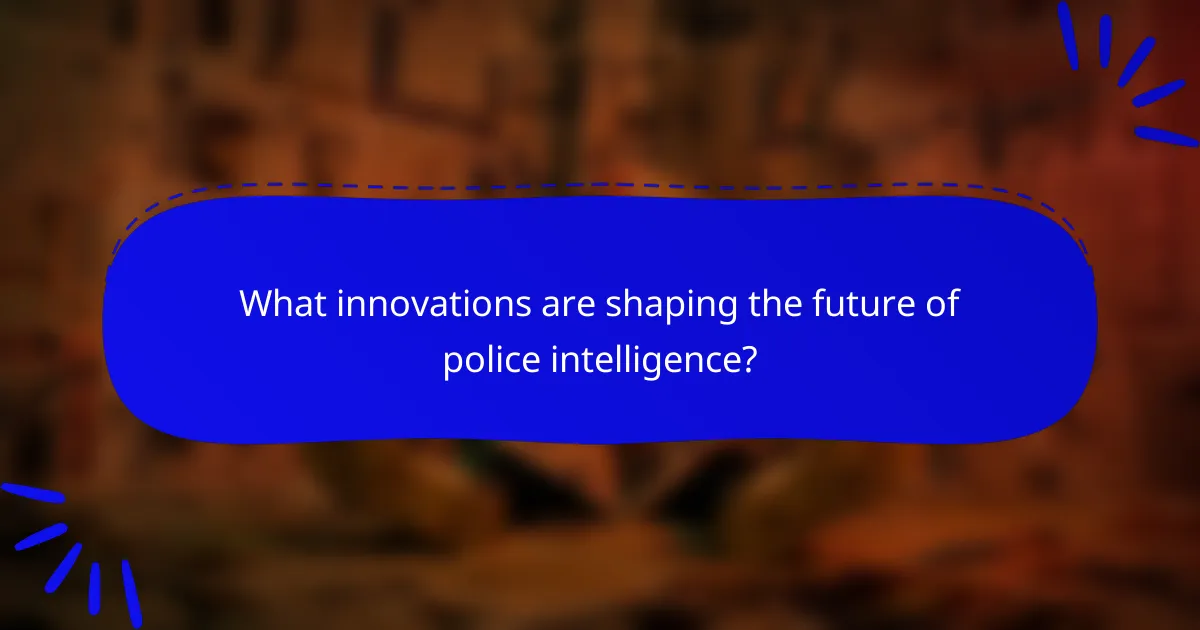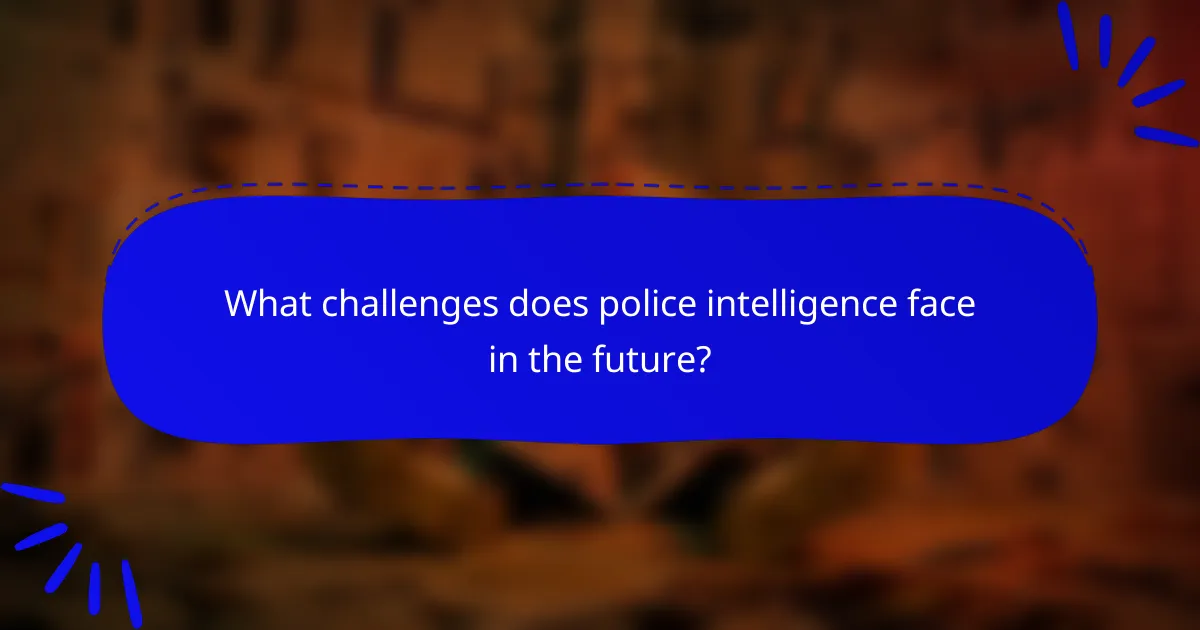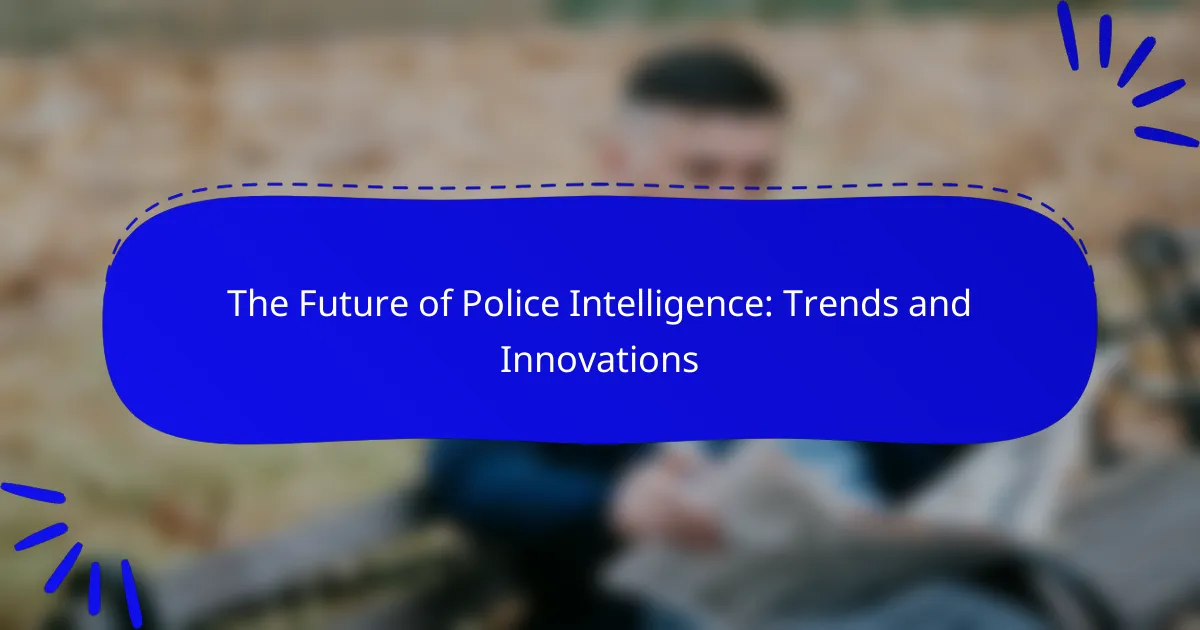
What are the current trends in police intelligence?
Current trends in police intelligence include the integration of advanced technology, data analytics, and community engagement. Law enforcement agencies are increasingly using artificial intelligence to analyze large datasets. Predictive policing models help identify potential criminal activity before it occurs. Enhanced communication tools facilitate real-time information sharing among agencies. Social media monitoring aids in gathering intelligence from public platforms. Collaboration with private sector technology firms is on the rise. Training in data-driven decision-making is becoming essential for officers. These trends reflect a shift towards more proactive and informed policing strategies.
How is technology transforming police intelligence?
Technology is transforming police intelligence by enhancing data collection and analysis. Advanced software allows for real-time data integration from multiple sources. This includes social media, surveillance systems, and public databases. Predictive analytics now helps law enforcement anticipate criminal activity. Machine learning algorithms identify patterns and trends in crime data. Geographic Information Systems (GIS) provide visual mapping of crime hotspots. Drones and body cameras improve surveillance capabilities and evidence collection. As a result, police can respond more effectively and allocate resources efficiently.
What role does artificial intelligence play in police intelligence?
Artificial intelligence enhances police intelligence by analyzing vast amounts of data rapidly. It helps identify patterns in criminal behavior and predicts potential crime hotspots. AI algorithms process information from various sources, including surveillance footage and social media. This capability improves situational awareness for law enforcement agencies. AI tools can automate mundane tasks, allowing officers to focus on critical investigations. Studies show that AI can reduce response times and improve resource allocation. For instance, predictive policing models have demonstrated effectiveness in several cities, leading to a decrease in crime rates. Overall, AI plays a vital role in modernizing police intelligence practices.
How are data analytics tools enhancing police operations?
Data analytics tools are enhancing police operations by improving decision-making and resource allocation. These tools analyze vast amounts of data to identify crime patterns and trends. For instance, predictive analytics can forecast potential crime hotspots. This allows law enforcement to allocate officers more effectively. Additionally, data analytics aids in investigating incidents by correlating various data sources. It can also streamline administrative tasks, reducing paperwork and improving efficiency. A study by the Police Executive Research Forum found that agencies using data analytics reported a 10-20% reduction in crime rates. Overall, these tools are transforming how police departments operate and respond to incidents.
What are the emerging methodologies in police intelligence?
Emerging methodologies in police intelligence include predictive analytics, data fusion, and social network analysis. Predictive analytics uses historical data to forecast potential criminal activities. This approach enhances resource allocation and strategic planning. Data fusion integrates various data sources for a comprehensive view of crime patterns. It allows for better situational awareness and informed decision-making. Social network analysis examines relationships and interactions among individuals involved in criminal activities. This technique helps identify key players and potential criminal networks. These methodologies are increasingly adopted to improve the efficiency and effectiveness of law enforcement operations.
How is predictive policing shaping law enforcement strategies?
Predictive policing is shaping law enforcement strategies by using data analysis to anticipate criminal activity. Law enforcement agencies implement algorithms to analyze crime patterns. This approach allows them to allocate resources more effectively. For instance, cities like Los Angeles have reported reduced crime rates through targeted patrols based on predictive models. Studies show that predictive policing can lead to a 30% decrease in property crimes. Additionally, it helps in identifying potential hotspots for criminal activity. The integration of technology and data-driven insights enhances decision-making in policing. This shift towards predictive strategies reflects a broader trend in law enforcement.
What is the significance of community policing in modern intelligence?
Community policing is significant in modern intelligence as it fosters collaboration between law enforcement and communities. This partnership enhances information sharing and builds trust. Trust leads to better intelligence gathering from community members. Effective communication channels improve response times to crime and safety concerns. A study by the Bureau of Justice Assistance highlights that community policing strategies reduce crime rates. Additionally, community involvement helps identify local issues that require attention. Overall, community policing is essential for proactive policing and intelligence-led strategies.

What innovations are shaping the future of police intelligence?
Innovations shaping the future of police intelligence include artificial intelligence, predictive analytics, and data integration. Artificial intelligence enhances data processing capabilities. It allows for faster analysis of large datasets. Predictive analytics helps in crime forecasting and resource allocation. This technology uses historical crime data to identify patterns. Data integration improves information sharing among agencies. It ensures that all relevant data is accessible in real time. These innovations aim to increase efficiency and effectiveness in law enforcement operations. They also enhance public safety by enabling proactive policing strategies.
How are new technologies being integrated into police work?
New technologies are being integrated into police work through the adoption of advanced tools and systems. Police departments are utilizing body-worn cameras to enhance accountability and transparency. These cameras have been shown to reduce incidents of excessive force by 50%. Additionally, predictive policing algorithms analyze crime patterns to allocate resources more effectively. Studies indicate that cities using predictive policing have experienced a 20% decrease in crime rates. Drones are also being employed for surveillance and crowd monitoring during events. The use of automated license plate recognition systems helps in quickly identifying stolen vehicles. Overall, these technologies improve efficiency and enhance public safety in law enforcement.
What advancements in surveillance technology are being utilized?
Advancements in surveillance technology include AI-powered [censured] recognition systems. These systems enhance the ability to identify individuals in real-time. Drones equipped with high-resolution cameras are also increasingly used for aerial surveillance. They provide broad coverage and can monitor large areas efficiently. Body-worn cameras have become standard for law enforcement, improving transparency and accountability. Additionally, smart streetlights with integrated cameras are being deployed in urban areas. These lights can capture footage and monitor public spaces effectively. Lastly, data analytics tools are utilized to process vast amounts of surveillance data. This enables law enforcement agencies to detect patterns and predict criminal activity.
How is mobile technology impacting police intelligence gathering?
Mobile technology is significantly enhancing police intelligence gathering. It allows officers to access real-time data and communicate instantly. Mobile devices enable the collection of evidence through photos, videos, and audio recordings on-site. This immediacy improves the accuracy of information gathered during investigations. Additionally, mobile applications facilitate the sharing of intelligence across departments and jurisdictions. According to a report from the International Association of Chiefs of Police, 70% of law enforcement agencies utilize mobile technology for data collection. This trend demonstrates a shift towards more efficient and effective policing methods.
What collaborative efforts are enhancing police intelligence?
Collaborative efforts enhancing police intelligence include partnerships between law enforcement agencies and technology firms. These collaborations facilitate the sharing of data and resources. Joint task forces are formed to address specific crime trends. Inter-agency communication networks improve information flow. Community engagement initiatives foster trust and information sharing with the public. Academic partnerships contribute research and innovative solutions. Intelligence-sharing platforms enable real-time data access across jurisdictions. These efforts collectively enhance situational awareness and response capabilities.
How are partnerships between law enforcement and tech companies evolving?
Partnerships between law enforcement and tech companies are evolving through increased collaboration and integration of advanced technologies. Law enforcement agencies are leveraging artificial intelligence, data analytics, and surveillance tools provided by tech firms. This shift aims to enhance crime prevention, investigation efficiency, and public safety. For instance, companies like Palantir and Axon are developing software that aids in real-time data analysis for police departments. Additionally, there is a growing emphasis on ethical considerations and community trust in these partnerships. Recent studies show that transparency in data use fosters public confidence. Overall, the evolution reflects a trend towards smarter policing and adaptive technology solutions.
What role do international collaborations play in police intelligence?
International collaborations enhance police intelligence by facilitating information sharing and resource pooling. These partnerships allow law enforcement agencies from different countries to exchange critical data on criminal activities. Collaborative efforts improve the analysis of transnational crime, such as drug trafficking and terrorism. For example, organizations like Interpol and Europol provide frameworks for cooperation. Such frameworks enable timely responses to emerging threats. Additionally, joint training programs improve operational capabilities across borders. Statistics show that international collaboration can lead to a significant increase in successful investigations. In 2020, Interpol reported that joint operations resulted in over 1,500 arrests globally. This illustrates the effectiveness of collaborative efforts in enhancing police intelligence.

What challenges does police intelligence face in the future?
Police intelligence will face several challenges in the future. One major challenge is the increasing complexity of crime, including cybercrime and organized crime networks. These sophisticated criminal activities require advanced analytical capabilities and technology. Another challenge is the need for data privacy and civil liberties considerations. Balancing effective policing with individual rights is crucial. Additionally, police intelligence must contend with evolving technology, such as artificial intelligence and machine learning. Adapting to these technologies while ensuring ethical use is essential. Furthermore, collaboration between agencies and jurisdictions poses logistical hurdles. Effective communication and information sharing are vital for successful intelligence operations. Lastly, budget constraints may limit resources for training and technology upgrades. These financial limitations can hinder the effectiveness of police intelligence efforts.
How do ethical considerations affect police intelligence practices?
Ethical considerations significantly impact police intelligence practices by guiding decision-making and operational protocols. These considerations ensure that intelligence gathering respects civil liberties and human rights. For example, the use of surveillance technologies must balance public safety with individual privacy rights. Ethical frameworks help prevent abuse of power and discrimination in intelligence operations. They encourage transparency and accountability in police actions. Studies show that ethical practices can enhance community trust in law enforcement. Trust is essential for effective policing and cooperation from the public. Thus, ethical considerations are vital for responsible and effective police intelligence practices.
What are the privacy concerns related to police intelligence technologies?
Privacy concerns related to police intelligence technologies include surveillance overreach and data misuse. These technologies, such as [censured] recognition and predictive policing, can infringe on individual privacy rights. They often collect vast amounts of personal data without consent. This data can be used for purposes beyond law enforcement, raising ethical issues. Additionally, there is a risk of biased algorithms leading to unfair targeting of specific communities. Historical cases, like the use of warrantless surveillance, highlight these risks. Public backlash has prompted discussions on regulation and accountability in police practices. Overall, the balance between security and privacy remains a critical challenge.
How can police departments balance security and civil liberties?
Police departments can balance security and civil liberties by implementing transparent policies. These policies should ensure accountability in law enforcement practices. Community engagement is essential for building trust. Regular training on civil rights for officers can enhance understanding. Data collection methods must respect privacy rights. Oversight bodies can monitor police actions effectively. Public feedback mechanisms can guide departmental policies. Research shows that transparency improves community relations and compliance.
What barriers exist to the implementation of new technologies?
Barriers to the implementation of new technologies include high costs, resistance to change, and lack of training. High costs can deter police departments from adopting new systems. Resistance to change often stems from established practices and skepticism about new methods. Lack of training can hinder effective use of technology, creating a gap in operational efficiency. Additionally, outdated infrastructure may not support advanced technologies. Privacy concerns also pose significant challenges, as new tools can raise questions about data security and civil liberties. These barriers collectively impede the integration of innovative solutions in police intelligence.
How do budget constraints impact police intelligence innovations?
Budget constraints significantly limit police intelligence innovations. Limited funding restricts the acquisition of advanced technologies. Police departments may struggle to implement data analytics tools or artificial intelligence systems. This lack of resources can hinder effective crime analysis and predictive policing. Additionally, budget cuts often lead to reduced personnel, impacting the ability to gather and analyze intelligence. Historical data shows that departments with higher budgets can adopt innovative practices more rapidly. For example, a 2021 study by the Police Executive Research Forum found that agencies with robust funding reported better outcomes in crime reduction through technology use. Thus, budget constraints directly affect the pace and effectiveness of police intelligence innovations.
What training is necessary for officers to effectively use new tools?
Officers require comprehensive training to effectively use new tools. This training should include hands-on workshops focused on tool functionality. Officers must also engage in scenario-based training to apply tools in real-life situations. Understanding data analysis techniques is critical for officers using intelligence tools. Training should cover cybersecurity protocols to protect sensitive information. Continuous education on emerging technologies is essential to keep skills updated. Additionally, collaboration exercises with technical support teams can enhance tool utilization. Regular assessments can ensure that officers remain proficient in using new tools.
What best practices can enhance the effectiveness of police intelligence?
Implementing data-driven decision-making enhances the effectiveness of police intelligence. This practice involves analyzing historical crime data to identify patterns and trends. Utilizing predictive analytics can help allocate resources more efficiently. Collaboration with other agencies improves information sharing and intelligence gathering. Training personnel in advanced analytical techniques equips them with necessary skills. Establishing clear communication channels fosters timely dissemination of intelligence. Regularly updating technology ensures access to the latest tools for data analysis. Engaging with community stakeholders builds trust and encourages public cooperation. Collectively, these best practices strengthen the overall effectiveness of police intelligence operations.
How can ongoing training improve police intelligence operations?
Ongoing training can significantly enhance police intelligence operations by improving skills and knowledge. Regular training updates officers on the latest investigative techniques and technologies. This ensures that they remain effective in gathering and analyzing intelligence. Enhanced training fosters better collaboration among officers and agencies. It promotes a shared understanding of protocols and procedures.
Studies indicate that departments with continuous training programs report higher success rates in solving cases. For instance, the Police Executive Research Forum found that ongoing training improves decision-making and operational efficiency. This ultimately leads to more informed strategies and effective crime prevention.
What strategies can foster community trust in police intelligence efforts?
Engaging the community in police intelligence efforts fosters trust. Transparency in operations builds credibility. Regular community meetings allow for open dialogue. Collaborative initiatives with local organizations enhance relationships. Training officers in cultural competency improves interactions. Utilizing community feedback in decision-making shows respect for public input. Demonstrating accountability through audits and reports reinforces trustworthiness. These strategies have been shown to improve community perceptions of police effectiveness and integrity.
The main entity of the article is police intelligence, which encompasses the strategies and technologies used by law enforcement to gather, analyze, and utilize information for crime prevention and investigation. The article explores current trends such as the integration of advanced technologies, including artificial intelligence and predictive analytics, that enhance data analysis and operational efficiency. It discusses emerging methodologies like data fusion and social network analysis, and highlights the significance of community policing and collaboration with technology firms. Additionally, the article addresses challenges related to ethics, privacy, and budget constraints that impact the future of police intelligence operations.
